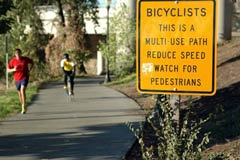
near the Hawthorne Bridge in Portland.
(File photos © J. Maus)
I came across a story this morning that I feel has important lessons for multi-use path users here in Portland and beyond. A woman has died after being hit by someone riding a bike on the Katy Trail outside of Dallas, Texas.
Here’s how the collision occurred, according to a local TV report:
According to police reports, 28-year-old Lauren Huddleston abruptly turned left just as a woman on a bike tried to pass her.
Witnesses told police Huddleston had been wearing headphones and likely didn’t hear the bicyclist.
Huddleston sustained head injuries in the collision and died in a hospital a week later.
Portland has several popular multi-use paths full of people jogging and riding bikes and the issue of sharing the path has come up before. Thankfully, we have yet to experience a fatal collision, but as anyone who has used the Eastbank Esplanade or the Springwater Corridor Trail can attest, the potential is certainly there.
The story from Dallas is particularly interesting because it brings up behaviors from both parties that are worth noting. First, wearing headphones while jogging or biking is not a good idea, yet it happens all the time (coincidentally, I was thinking about it for this week’s “Ask BikePortland” column). And second, when passing another path user, it is the responsibility of the person passing to expect the unexpected and to be traveling at a speed slow enough to react if necessary.
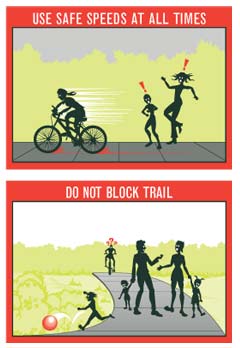
created by PBOT in 2007.
This issue of sharing the path is one where the City of Portland has taken a proactive approach. They’ve been quiet about it lately, but back in 2007, the City’s Transportation Options Division held an event and even created a brochure to promote path courtesy.
One final thought on this issue that doesn’t always get the attention I feel it deserves. Yes, it’s important for path users to share, but the larger issue here is that there are simply not enough non-motorized corridors. Off-street paths like the Katy Trail, and the Springwater and Esplanade are great, but they are too few and far between as increasing amounts of people look to use them for both recreation and transportation. Besides a call for more courtesy, we simply need more trails to adequately serve the non-motorized population. And, as someone pointed out in the comments below, when we do build new non-motorized corridors, we need to push for wide facilities and separation like they have in Vancouver, BC (photos below from my trip there a few years ago).
Be courteous out there folks — even while on off-highway paths and trails. As this story from Dallas shows us, a bike can be just as deadly as a car.


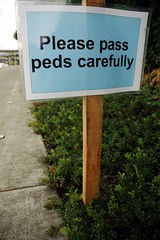
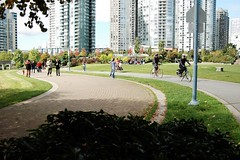

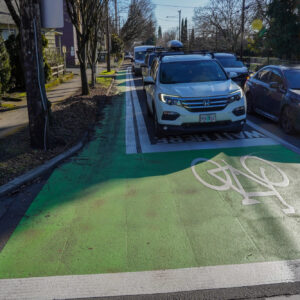
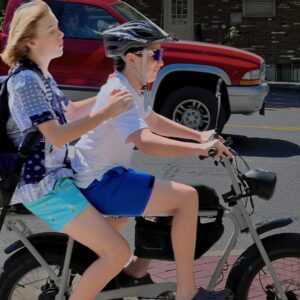

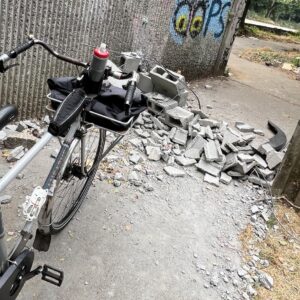
Thanks for reading.
BikePortland has served this community with independent community journalism since 2005. We rely on subscriptions from readers like you to survive. Your financial support is vital in keeping this valuable resource alive and well.
Please subscribe today to strengthen and expand our work.
The article fails to mention the jogger’s lack of a helmet. Nearly 100% of deaths in bike vs ped accidents are caused by head injuries, far higher than the percentage of cyclist deaths…shouldn’t we place the blame firmly on the helmetless pedestrian? After all it was her choice to run without a helmet wasn’t it?
Think about it the next time someone does the same with a cyclist hit by a car.
Bjorn,
You can place the blame with whomever you see fit. I didn’t post this to try and figure out what was at fault. The bigger issue here for me is that too many people do not take path courtesy seriously — I see it all the time when I’m on the Esplanade and the Springwater. The problem I see is that these paths have conflicting, dual uses. Tourists and people doing fitness activities are in a different safety awareness space than people who are rushing home or to work. Again, I think the big picture is that there is an inadequate amount of non-motorized facilities and the supply has not kept up with the demand.
I read the comments on the Dallas paper’s website, and there were at least two accounts of pedestrians who had been passed by that biker immediately before the accident, and both accounts said that the biker was audibly signaling, and going at a reasonable speed and in control.
I ride on a MUP a lot, and this is my worst nightmare- people with headphones, zoned out and not hearing my bell or my calling out. In this case the pedestrian died, but it could almost as easily have been the biker who was injured by falling while trying to avoid the collision.
On a rutted, narrow path, sometimes there’s just not enough space to pass with enough space to allow for every possible pedestrian action.
When I was a racing runner, I learned pretty quickly to shoulder check before passing or moving out of line in a pack, and I think it’s a good habit for all runners or other pedestrians to learn when they use a crowded MUP.
I see cyclists and joggers practically brushing the shoulders of peds. All it takes is for one of these peds to take a half a step in a different direction and you get a pretty serious collision that wouldn’t be very pretty for either person.
Sad story. It’s definitely something that could happen around here (I’m thinking of the Springwater trail), but I think a bigger risk is that one of these days there may be a fatality on the Hawthorne Bridge as someone gets shoved out into the roadway.
My mom broke her arm in a very similar accident. she was walking along and just decided to turn off the path (not at a trail intersection) without noticing a biker passing her. The biker had a broken collarbone. I tend to place the fault on the pedestrian… however they are just being oblivious, not thinking of the path as a transportation corridor where bikes are trying to make time.
I wish Portland would go down the path (literally, ha) that cities like Vancouver, BC have adopted, of constructing SEPARATE bike and ped lanes for their multi-use paths. Like this!
http://www.flickr.com/photos/bikeportland/1437463914/
Even the new sections of multi-use path that are being constructed right now here in Portland still dump bikes & peds together.
Recipe for disaster as more and more people out there choose to bike and walk 🙁
I ride down the esplanade everyday to work. Last summer as I was on my way home on a new road bike a pedestrian suddenly turned left in front of me. I had a second to react so he did not end up falling over but my wheel made contact with his leg and my chain popped off. We were both a bit shaken up and some people who witnessed it said he should have been paying more attention. I think we are all guilty of lapses in awareness from day to day. This story is a good reminder that life is fragile. Speed should not have a higher value than human safety.
This is a new twist to the “divide and conquer” strategy, except it’s ” combine and conquer”, or more accurately, “cram together and conquer”. Too many divergent needs and speeds on too small a space. MUPs are not a long term solution.
Multi-Use paths are nice for recreational use. The problem is that they are also designed to function as commuter highways. As a recreational user, I don’t mind slowing down and toodling along behind tourists or groups of chatty Cathies until it’s safe to pass. However, as a commuter, I have a schedule and am moving from point A to point B as quickly as possible. As more people transition to using the bicycle as transportation, this conflict will grow.
What a tragedy, thank you Jonathon for posting this and giving our bike community thought for caution again. I agree that there are not enough non motorized routes in town–ideally pedestrians and bikes would have their own lanes as seen in European Boulevard sidewalks.
I find Bjorn’s and Allan’s remarks bordering on the offensive. Joggers and pedestrians should wear helmets?? And “tend to place the fault on the pedestrian… however they are just being oblivious, not thinking of the path as a transportation corridor where bikes are trying to make time.” sounds like an what a car driver could say about bikes. Come on, the mode of transportation that is faster and physically more durable(metal versus flesh) must watch out for and yield to those less so. Isn’t this the continual argument against cars???
The hierarchy absolutely is pedestrians > bikers > cars. And of course everyone should be defensive.
Bottom line is NO ONE should die because they are hit by a bike.
By the way, if this occured on a shared trail, and there are near misses on Springwater and the Esplanade all the time, how can any cyclist ever suggest that trails in Forest Park should be shared?
I’m an early morning rider — from San Francisco to Marin County…I frequently encounter a similar problem: Cyclists with EXTREMELY bright lights on the bike path. So bright, in fact, that it’s nearly impossible to see the joggers right in front of you when the LiteBrites are passing you in the opposite direction. Drivers typically get the ‘high beam’ thing, why not cyclists?
The simple fact is that however much we champion our city and its vaunted bicycle network it is merely a band aid ineptly applied (check the Morrison Bridge bike path fiasco) and it looks like amateur hour compared to many cities around the world . This is not to knock PBOT who do a great job by American standards, it’s just that American standards are very low. The system is evidently bulging at the seams through overuse and an accident similar to that which happened in Dallas will happen here…..guaranteed.
Bjorn,
the rules governing travel on a roadway are different than those on a multi-use path. And a walker is NEVER considered a vehicle. Walking/jogging speeds seldom create the kind of momentum needed for a fatal head injury. Getting hit by a moving object does…..as does crashing while in a moving vehicle.
So the pedestrian is at fault for her head injury, but it a cyclist gets hit by a car (helmet or not) it’s the car’s fault. At what point does the cyclist ever have any responsibility/liability?
I’m not saying the ped is guiltless – they should have looked ove their shoulder. but the cyclist should have been aware to the more vulnerable person and takent he reposonsibility to avoid such an accident. After all, that’s exactly the same argument people on this board use when referring to autos.
It appears from the article, that the trail only has signs directed to the bicyclist.
Unfortunately, until there are signs directing the pedestrian to look back before crossing the problem will continue.
As a cyclist, we do not have the swift lateral motion needed to avoid a pedestrian that serves in front of us.
While bicycle etiquette is a factor in some situations, pedestrians on a multi-use trail – need to look back and check for cyclists, joggers, roller-skaters etc before crossing the trail.
This helpful sign should be a fairly easy to design and install.
I have to disagree here… it’s your responsibility to avoid everything you can in front of you… but a slow enough speed to react to somebody stepping in front of you is stopped… that’s why it’s not your fault when people jump in front of you without allowing you time to react, there is no time…
every pedestrian on a multi-use trail should know that there are other people on the trail that may go faster than them in some form… if they don’t then they’re the typical inconsiderate type and they will be mowed down by faster walkers, joggers, and bicycles when they’re sidestepping without looking…
Tragic.
I was kind of surprised about a year ago when I noticed my tendency to look over my shoulder (which has become second nature) and even hand-signal direction changes while walking.
As if that would ever catch on.
Greg, (#10)
Good points re: commuting vs. recreating.
But then there are the in-training cyclists using the MUP who are often going way faster than a commuter. They are dangerous not only to walkers but to other bicyclers.
The training cyclists need to be on surface streets where their speeds are closer to auto traffic than they are to users of the MUP.
Jim – all those photos/brochures are from here in Portland!
i avoid mups for precisely this reason, especially in nice weather. if i must, i barely go faster than a pedestrian.
The reason this issue isn’t discussed more is because really it’s a non-issue – these types of accidents are just not very common. So long as bikes and pedestrians are going to be mixed together, though, they will be unavoidable. Some people are oblivious, some people know exactly what they are doing and are rude, and do whatever they want whether it endangers others or not. We can’t really do anything to change those people’s behaviors, so we must each one of us be prepared to change our own behaviors instead. As with sharing the road, where cars retain the responsibility of safety for their damage potential, bikes must take responsibility on MUPs to be as, if not more, vigilant than pedestrians in our respective quests for safety. Even in the cases of less mass (light rider on a light bike vs big, tall, lumbering pedestrian), the momentum of the moving bicycle will transmit considerable force into another object on collision and could cause serious harm. Try to keep that in mind when you are passing – slow down, give warning and pass with as wide a berth as you can. If it isn’t safe to pass, e.g., when there is oncoming traffic, don’t try to squeeze through just because you fit. Wait for traffic to clear, announce your pass, and then do so cautiously. If all this slows you down too much, find a route on surface streets where you can cut it up with some cars and have it be your own safety at risk due to your impatience.
/rant off
Adam #7 is spot on about Vancouver’s separate non-motorized paths. That city is amazing. Personally, I jog with an iPod around 50% of the time and my cycling has taught me to keep the volume low and keep my eyes open.
I think that for some reason more and more Portlanders have a sense of entitlement that tells them it’s okay for their dogs, leashed or unleashed, to haphazardly dart all over a path and they themselves can block the entire width just to have a conversation with one other fellow walker, jogger, loiter, or whatever.
I think both parties in Dallas share the blame. There are OTHERS in our world (the nerve of them!) and some people forget that.
I’m completely with pdxthinker: inasmuch as I’m quick to anger when I’m buzzed by a car, I’m equally upset when I see a bike buzz a pedestrian; it’s completely unsafe to pass someone on foot too closely at regular speed, because you can’t assume they’ll do the right thing–you know, just like we get angry when cars do the same thing to us! How can we demand that cars respect us by giving us proper space–and occasionally cut us some slack for our mistakes–if we don’t do the same for pedestrians?
I know the infrastructure isn’t close to being perfect, but in the meantime, can we stop treating human beings like slalom poles in a ski race?
Is there a speed limit on the Sellwater corridor? If I’m training at 25-30 mph am I just being potentially inconsiderate/dangerous or is it actually illegal?
1. I don’t even bother trying to communicate anymore with the joggers and cyclists I pass who are wearing earphones, it’s pointless.
2. The Esplanade and Springwater trails were underdesigned right from the start, they need to be wider to accomodate all the users.
I struck a ped about 6 years ago on the Esplanade between the Hawthorne Bridge and OMSI. I was going about 10 mph and had plenty of room to the guy’s left. I called out an “on your left”, but just as I came upon him he finished his jogging circuit and made a quick buttonhook right into me. Both of us were hurt and pretty shaken up. My helmet was egg-shelled and he ended up with a pretty good knot on his head. He hadn’t heard my warning because of his ear-buds. I was lucky to learn a lesson early in my bicycle commuting career. Always consider the surprise move. Can you stop/avoid in time?
I changed my riding habits since that day, knowing I want to keep doing it for many years. I cringe every time I see someone fly by me in front of OMSI with kids running around and tourists wandering oblivious. Slow down and be careful for you and them.
Bjorn,
I took your comment with a certain amount of intended sarcasm and trust that your tongue is planted firmly in your cheek. I hope this is the case. Jonathan’s reply was spot on that there is a larger issue here and I believe you understand that and are just trying to make a totally different point through irony.
OK, this allows me to bring up my one of my pet peeves. If you are on a bike, and you want to signal with a bell or an “on your left” – you need to give plenty of time for the pedestrian to react. Almost all the time, bicyclists will ring/call out when they’re about ten feet or less which, unless the bike is going unusually slowly, is not nearly enough time for the pedestrian to do anything at all (except maybe get startled). Don’t believe me? Just try walking across the Hawthorne bridge during rush hour and see how quickly you can react.
1.5 seconds is the typical number that’s used in these situations, so if you’re traveling at a moderate 10mph (14.7 ft/sec) you need to sound out no later than 22 feet away, but if someone is engaged in something else like talking to someone, you need to add even more time/distance.
Me, when I’m passing pedestrians, I actually don’t call out while riding quickly. I either give a very wide berth (at least five feet, better yet ten) or slow the heck down so I’m not going much faster than the pedestrian and let them know in a normal voice (not a yell, which is likely to startle and make them more likely to do something unexpected) that I’ll be passing and give them plenty of time to react.
Two comments – the first is on design. The Sullivan’s Gulch Trail Committee has been thinking about this. Our ideal is a facility that separates cyclists from walkers, wheelers and others. The reason being we see the trail as a transportation facility first and foremost. Higher speeds for cycling will make for a more effective long commute. The challenge is getting the funding to pay for the extra space needed to do this.
The second comment is more personal. I jog, with earbuds, on the waterfront loop regularly. I think a little extra common sense is needed for all. I personally check my blind spot when running both before passing and just periodically to be aware of cyclists. Its easy to do and keeps me from being startled by the silent pass. I try to stick to the far right too – some walkers and runners seem to meander in the middle, no need to do that for no reason.
resopmok #21: I couldn’t agree more, especially with the first sentiment. Bike Portland seems to be a clearinghouse for every bike-related accident that occurs in the city (and apparently even those that occur outside of the city). While I know he’s just trying to raise issues, he’s inadvertently making cycling seem much more dangerous than it really is.
@27 yeah the point was that no one in the media would blame a jogger for not having a helmet on even though basically 100% of the time that pedestrians die when hit by bikes it is due to a head injury. When cyclists are killed by cars the odds of being saved by a helmet are much lower, yet news outlets insist upon the no helmet comment even in cases where it is clear that the fatal injury was not head related.
Sadly these accidents can’t be avoided in rare instances, especially with ever popular MUPs. My brother went through a painful recovery and several thousand dollars of dental work after he collided while jogging with a pedestrian who suddenly veered into his path.
He is in Van, BC and one of the things they’ve done there in Stanley Park is segregate lanes for bikes and peds. Are there any other MUPs out there that do this?
The same rules should apply as when skiing: the downhill (in this case “ahead of you”) trail user has the right of way, it is your responsibility to avoid them.
I give pedestrians a wide berth both out of courtesy and for safety. I’ve walked across the Hawthorne enough to know that it’s no fun to get buzzed even at relatively slow speeds (15 mph or so).
On a side note, what kind of injuries does a cyclist typically experience when hitting a pedestrian? I’d imagine that you could get hurt just as badly as whoever you run into — is that not the case?
@Erik Tonkin (#24)–not sure about the legal issue, but man, why on earth would you go 25-30 mph on a shared path? It’s like the folks who drive 45mph on a residential street. Most of the time no one gets hurt, but it seems like a recipe for disaster. Surely there are other places for you to train.
We desperately need signs warning pedestrians to look for bicycles on the hawthorne bridge. Tourists and out of towners often act in dangerous and unpredictable manner on this path. I believe the cycling speed limit should be lowered from 15 mph to 10 mph on the Hawthorne bridge. This article has inspired me to make a permanent switch to the Morrison.
the best and least stressful way to walk on these MUPs is on the left, facing the oncoming bike traffic, rather than on the right.
thinker, I think the analogy to cars is kind of useless, as I’m am confident most people would blame the cyclist, if a car was passing us and we (without looking) just turned right in front of the car. In this situation it is the cyclists fault, much like in the article’s situation it is the pedestrian’s fault (esp. since it seems pretty clear the cyclist was vocally signally when passing peds.)
And trail sharing can work in Northern FP, where there is a whooping 1-5 pedestrians/hr. on the wildwood. That is not exactly the same density of users as on the Eastbank Esplanade.
This is a very sad story. There’s no question that Portland’s pathways could use more striping, signage, and enforcement to keep people well-behaved.
dont forget about hh and deaf out there. they are usually not be able to hear your yelling, braying, yowling, howling, ringing, honking whatever, so always be prepared! to slow down and pass safely. We never mean to be rude. 🙂 People with kids and dogs, watch out for them also…
Where people are there, slow down please.
Very sad. A death is rare, far more common is minor injury. People who wear earbuds on a public way are just pain self centered.
Their entertainment is paramount to the safety of others. They don’t get it.
A cyclist recently squeezed between a car and my bike on the Williams bike lane. He was rushing to the stoplight where we sat together for 20 seconds. I asked him a question, and he took off his buds and said “what?” I asked if he cares about putting my safety at risk. 2 blocks later he nearly got run down by an Ambulance he could not hear.
Had he died, the folks at his memorial would have said he was such a “nice guy” and sued somebody else.
I’ve had plenty of near misses on the Springwater especially now that it is starting to get darker. I’d say that 90% of joggers have something in their ears and can’t hear my signals when I pass them so I have to ride defensively and expect the unexpected.
Another factor is that many joggers on the Springwater trail near oaks bottom have no reflective clothing or even lights on them in the darker months and I’ve suddenly come up upon them multiple times. Brighter lights on my bike help.
There is no way really to get around this other than to ride carefully especially when children or dogs are using the path.
Add Leif Ericson to that list of shared paths with numerous potential sources of problems…. too fast cyclists, blind corners, dogs off leash, long leashes, head phones, unpredictable children, people spread across the trail etc…
As wide as that trail is, I had to leave the trail on my bike as a group of oncoming runners were taking the whole width of the trail and were clearly taking the whole bike yeild to peds things a little too serious. There were 10 of them (college cross country team?) and seemed to be looking for a little confrontation.
Van #41: I learned a couple years ago that REAL lights (not just “be seen” lights) are necessary on the Springwater. Not only do the joggers and peds wear dark clothing, but you’ll get at least a couple of cyclists with no lights at all. I had a near-miss with a cyclist that I couldn’t see until it was almost too late. After that I bought a light that was bright enough for me to see way out in front of me and have felt much safer for it; the piece of mind was well worth the money I paid.
Not so long ago, a woman was killed when a cyclist collided with her on a recreational trail up in Washington.
Elderly Renton woman hit by bike rider on Cedar River Trail identified/By DEAN RADFORD/Renton Reporter Editor/Apr 19 2010
There was a lot of discussion about this collision at bikeforums (haven’t so far been able to locate the thread). More stories were written about this collision than the one I posted the link for. Here’s a link to one that tells who this person was (note the sidebar listing other Renton Reporter related stories):
Velda Mapelli was vibrant and a downhill skier/Renton Reporter/May 13 2010
When bicycles are looked at as recreational devices, the conflict issues around these paths are a clearcut case of courtesy.
However, the truth is that bikes are actually a real mode of transportation, and while it may be convenient to make a path and call it “multi-use”, the reality is that this is combining a sidewalk with what is essentially a bike freeway. Real bikeways (of whatever form) for actual transportation should not have such a fundamental conflict built-in.
I like to make little jingles and beats with my bell as I ride through the congested waterfront path from downtown to the steel bridge. Actually sometimes I do it wherever I am just because I’m kinda fidgety.
However, I have run into a bit of a limit with my creative ability/thumb maneuverability on the lever but unless I’m riding with my wife, I don’t think anyone else notices my lack of repertoire. Sometimes she messes with me about it but she’s not the one bustin’ out some dope cuts on her bike bell. And some afternoons I have a breakthrough and all the sudden create a new beat or a funky addition to my current beats.
I’m looking forward to winter time when my paths are very nearly empty or at least the people out there (both seasoned joggers and bikers) seem to be more understanding of the ways of the path.
Around 60 people per year are killed by lightning strikes.
I can not even find a statistic for pedestrian fatalities by bicycle.
This type of thing is so freakishly rare, that I am astounded we are even discussing it.
Dan, 33.
I disagree with treating it like a ski slope. While skiing, “swerving” is the main way to control your speed. Therefore, it is expected. I have seen traversing spelled out as an exception too on some occasions – sudden moves to cross a trail rather than in the process of a normal ski turn.
Even then, most people give a quick uphill look during their turns because right of way or not, getting hit hurts.
The issue is really a matter of awareness. That means looking before you move suddenly across a trail or mup. As much as cyclists should slow down, and proceed carefully (the “its my commute, and I need to be somewhere” sounds too much like car drivers) it does not always happen. You can not always trust other people to keep your safety in mind, either as a cyclist or as a pedestrian.
Pedestrians should pay attention, and bikes should try and expect sudden movement. If its dark, bring enough lighting to see unlit people.
Here is a strange one:
Yesterday afternoon I was cruising south on the 205 MUP at 10 mph enroute to an appointment at Kaiser. About 500 feet ahead four teenagers, walking towards me, were hassling a couple of grade school kids. “This could be trouble,” I thought. I sped up to 15 mph, to get past as quickly as possible.
The yellow KHS track fixie now is set up for cross, with 26 inch wheels, knobbies, 60 inch gear: wicked acceleration, extremely agile; closest thing to a fighter jet available to the public.
It was trouble. 50 feet to the quartet a young woman jumped into the right lane, feet spread, arms wide, facing me and daring me. At 20 feet per second I had not much time to think. Last year I had witnessed a purse-snatching by a young woman not far away, and TriMet has been reporting notable crime at the Clackamas Transit Center. “Mess with me, girl, and I’ll mess with you!”
So I rode straight for her, leaving enough track to dodge right. She chickened out, jumping to my left.
As we passed I gave her a Jim Brown/Walter Payton/ Emmitt Smith stiff arm to her left shoulder to spin her out of the way. It worked: she did not hit the bars nor catch the pedal. I proceeded unabated to my dermatology appointment, unconcerned with the rocks being shied at my rapidly receding self.
There are weird folk on this planet indeed! But our mothers and our football coaches told us the same thing: it is better to give than to receive! A moral: do not impede track-trained geezers riding yellow fixies set up for cyclocross!
@44
The Mayor of Renton was also hit by a bike while visiting the scene of the accident.
Now that section of the Cedar River Trail has a 10 mph speed limit for bikes and a mile-long dismount section.
The main road the parallels the trail is a busy multi-lane state highway.
@ Ethan –Bicycles are not yet considered legitimate modes of transportation in every state. Until they are — and this would require it to become a federal case, I think — we will continue to see inconsistencies in funding for and construction of sufficient amenities for non-motorist use. I also think it can indirectly discourage personal responsibility — “hey, my bike’s not a legal vehicle so I don’t have to worry…”
Just my $.02 —